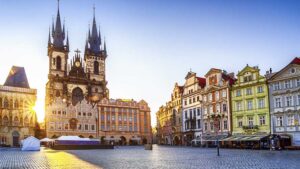Switzerland, often hailed as the jewel of Europe, is a country that offers something for everyone, no matter the time of year. Its magnificent Alps, serene lakes, quaint villages, and cosmopolitan cities make it a dream destination for nature lovers, adventure enthusiasts, and cultural explorers alike.
To make the most of your Swiss adventure, understanding the nuances of each season can be the key to an unforgettable experience.
Let’s dive into this and check what are the best time to visit Switzerland!
🌨️ Winter Wonderland (December to February)

Why Winter Switzerland is Magical
Switzerland transforms into a fairytale destination in winter. With snow blanketing the Alps, this is prime time for skiing, snowboarding, and sledding. Resorts like Zermatt, Davos-Klosters, and St. Moritz cater to everyone, from beginners to expert skiers. Even non-skiers can enjoy thrilling activities like tobogganing or snowshoeing.
Beyond sports, winter in Switzerland is a time for cozy, atmospheric experiences. Take a horse-drawn carriage ride through snowy villages like Gstaad or bask in the glow of Christmas markets in Zurich, Basel, and Montreux, which are famed for their festive lights, artisanal crafts, and warm mulled wine.
Winter Travel Highlights
- Glacier Express: Take this scenic train ride between Zermatt and St. Moritz for panoramic views of snow-laden peaks and frozen valleys.
- Ski School: Resorts like Verbier offer world-class ski schools, perfect for families or beginners.
- Igloo Hotels: Spend a night in a hand-carved igloo at places like Davos or Engelberg for an unforgettable Arctic experience.
Weather: Dress warmly; temperatures often range between -2°C and 7°C (28°F to 45°F).
Winter Packing Tips
- Essentials: Thermal underwear, heavy-duty gloves, and insulated waterproof boots.
- Extras: Sunglasses for the snow glare, and hand warmers for extra comfort.
🌼 Spring Serenity (March to May)
Why Spring is Special in Switzerland
Spring brings a quieter charm to Switzerland. As the snow melts, the valleys and meadows burst into color with wildflowers, while rivers and waterfalls, fed by melting snow, roar back to life. It’s an ideal time for nature walks, picnics, and enjoying Switzerland’s lakes at their most tranquil.
Cities like Lucerne and Bern awaken in spring, hosting outdoor festivals and farmers’ markets. Regions like Ticino, Switzerland’s Italian-speaking canton, boast Mediterranean-like climates in spring, perfect for exploring vineyards, lakes, and gardens.
Hidden Gems of Spring
- Swiss National Park: Visit before the summer crowds for peaceful hikes among awakening wildlife.
- Lauterbrunnen Valley: Witness the thundering Staubbach Falls as they flow at full force.
- Blossom Festivals: Attend cherry blossom events in Zug, famed for its orchards and picturesque lake views.
Weather: Temperatures range from 8°C to 15°C (46°F to 59°F), but it can still be chilly in mountainous areas.
Spring Tips
- Be Flexible: Weather can vary by altitude—carry an umbrella and layers for sudden showers or chilly mornings.
- Discount Opportunities: Spring is shoulder season, often offering lower prices on accommodations and transportation.
🌞 Summer Bliss (June to August)

Why Summer is the Peak of Adventure
Summer is Switzerland’s busiest season, and for good reason. With long daylight hours, clear skies, and mild weather, it’s perfect for outdoor adventures. The Alps beckon hikers, climbers, and paragliders, while Switzerland’s 1,500 lakes offer a range of water activities. Iconic trails like the Five Lakes Walk near Zermatt or the Eiger Trail provide awe-inspiring views.
City life also flourishes in summer. Zurich, Geneva, and Lausanne host lakeside festivals, open-air concerts, and bustling food markets. Swiss National Day (August 1) is a summer highlight, with fireworks, parades, and traditional Swiss celebrations across the country.
Unmissable Summer Activities
- Lake Geneva Cruises: Explore medieval castles and vineyards by boat.
- Cable Cars: Ride up to Schilthorn or Matterhorn Glacier Paradise for incredible Alpine views.
- Alpine Cheese-Making: Participate in cheese-making workshops in the Alpine dairies of Gruyère or Emmental.
Mild Alpine Weather: Long sunny days, with temperatures ranging from 18°C to 28°C (64°F to 82°F), allow you to explore the outdoors comfortably.
Summer Packing Tips
- Light but Sturdy: Breathable clothing, hiking boots, and a rain jacket for mountain weather.
- Extra Gear: Sunglasses, sunscreen, and a swimsuit for lake days.
🍂 Autumn Elegance (September to November)
Why Autumn is Underrated
Autumn is the best-kept secret of Switzerland. The summer crowds have dispersed, the weather remains pleasant, and the landscapes transform into a stunning palette of gold, orange, and red. Vineyards in Lavaux and Valais come alive with harvest activities, offering wine tastings and tours.
Hikers will appreciate the cooler temperatures and quieter trails, particularly in regions like Engadin or Jura Mountains. Meanwhile, cities such as Zurich and Lausanne host food festivals that showcase the best of Swiss culinary traditions.
Autumn Must-Sees
- Cattle Descent Celebrations: Witness colorful parades as cows are adorned with flower crowns and bells for their return to the valleys.
- Chateau de Chillon: Visit this iconic castle by Lake Geneva, framed by golden autumn leaves.
- Autumn Cuisine: Sample seasonal delights like mushroom risotto, pumpkin soup, and roasted chestnuts.
Weather: Cooler days, with temperatures ranging from 10°C to 20°C (50°F to 68°F), provide crisp air perfect for exploring.
Tips for Autumn Travelers
- Versatile Packing: Carry layers for crisp mornings and warm afternoons.
- Budget-Friendly: Many hotels and flights offer discounted rates during this off-peak season.
Packing Essentials by Season
Packing for Switzerland requires careful consideration of the season, as the weather can vary significantly, even within the same time of year. With its mountainous terrain and diverse climates, here’s how to prepare for each season to ensure comfort and readiness for all the adventures Switzerland has to offer:

Winter (December to February)
Switzerland’s winter is synonymous with snowy landscapes and chilly temperatures, especially in the Alps. Whether you’re hitting the slopes or exploring charming villages, staying warm and dry is key.
- Thermal Layers: Pack thermal underwear, wool socks, and insulated gloves to retain body heat.
- Ski Gear: If skiing, include goggles, a helmet, and ski gloves. Non-skiers should bring a warm hat and earmuffs.
- Heavy-Duty Outerwear: A down jacket with waterproofing is essential for combating freezing temperatures and snow.
- Waterproof Boots: Opt for sturdy, insulated boots with good grip to handle icy paths.
- Accessories: Don’t forget a scarf, hand warmers, and a moisturizing lip balm to prevent chapping in the cold air.
Spring (March to May)
Spring in Switzerland is a transition period, with unpredictable weather that can range from sunny and warm to cool and rainy.
- Layered Clothing: Pack long-sleeve shirts, light sweaters, and a midweight jacket to adapt to fluctuating temperatures.
- Waterproof Gear: A rain jacket or compact umbrella is crucial for spring showers.
- Comfortable Shoes: Bring waterproof walking shoes or boots for exploring trails or cities after rain.
- Daypack Essentials: Include sunscreen for sunny days and a refillable water bottle to stay hydrated while exploring.
Summer (June to August)
Summers in Switzerland are warm, particularly in the valleys, but cooler temperatures prevail in the high-altitude regions. Packing for versatility will keep you comfortable across these varied environments.
- Light, Breathable Clothing: Choose moisture-wicking fabrics for hikes and outdoor activities.
- Hiking Gear: Essential items include sturdy hiking boots, a hat for sun protection, and trekking poles for mountainous terrain.
- Swimwear: Perfect for cooling off in the country’s pristine lakes, such as Lake Geneva or Lake Lucerne.
- Sun Protection: Sunglasses, sunscreen (SPF 30+), and a wide-brimmed hat are a must for sunny days.
- Light Jacket or Sweater: Evenings can get cool, especially at higher altitudes.
Autumn (September to November)
Autumn’s crisp air and stunning foliage make it one of the most beautiful times to visit Switzerland, but temperatures can vary widely throughout the day.
- Warm Layers: Pack sweaters, a fleece jacket, and long pants for cooler mornings and evenings.
- Waterproof Jacket: Autumn rains are common, so a lightweight, waterproof jacket or coat is essential.
- Sturdy Footwear: Choose walking shoes or hiking boots with good grip for wet trails and leaf-covered paths.
- Accessories: Bring a scarf and gloves for extra warmth, particularly in late autumn.
- Reusable Water Bottle: Stay hydrated on scenic hikes or vineyard tours in regions like Lavaux or Valais.
General Packing Tips for All Seasons
- Swiss Travel Essentials: Always carry an adapter for Swiss power outlets (Type J) and a universal travel plug.
- Backpack or Daypack: Perfect for carrying snacks, maps, and water while exploring cities or trails.
- Reusable Water Bottle: Take advantage of Switzerland’s abundant drinking fountains for free, clean water.
- Camera Gear: Switzerland’s breathtaking landscapes are photogenic year-round—don’t forget extra batteries and memory cards.
- Medicines & Toiletries: Pack motion sickness remedies for winding mountain roads and a small first-aid kit for emergencies.
No matter when you visit, being well-prepared ensures you’ll enjoy Switzerland’s diverse beauty and adventures comfortably and stylishly!
Key Tips for Travelers
Switzerland’s stunning landscapes and rich culture make it a dream destination, but proper preparation ensures you can make the most of your trip. Here are some key tips for travelers:

1. Language Diversity
Switzerland boasts four official languages—German, French, Italian, and Romansh—each dominating specific regions.
- German: Spoken in central and eastern Switzerland (e.g., Zurich, Lucerne).
- French: Used in the western cantons like Geneva and Lausanne.
- Italian: Predominant in the southern region of Ticino.
- Romansh: Found in parts of southeastern Switzerland, though less common.
Tip: Learn basic phrases such as “Grüezi” (hello in Swiss German) or “Bonjour” (hello in French). Locals appreciate the effort and may respond warmly. English is widely understood in tourist areas but less common in rural regions.
2. Currency Matters
Switzerland uses the Swiss Franc (CHF), not the Euro, though some places may accept Euros at a poor exchange rate.
- Carry Cash: Particularly useful for small vendors, mountain huts, or rural areas where card payments might not be available.
- ATMs: Widely available, offering a convenient way to withdraw CHF.
- Currency Cards: Consider preloaded travel cards for better exchange rates and convenience.
3. Stay Hydrated
Switzerland’s drinking fountains are a highlight, offering clean, fresh, and free water across cities, towns, and hiking trails.
- Look for fountains marked “eau potable” (drinkable water).
- Eco-Friendly Tip: Carry a reusable water bottle to reduce waste and save money.
4. Plan for Peaks
Switzerland’s mountain attractions, such as Jungfraujoch and Gornergrat, are iconic but often crowded.
- Book Ahead: Reserve tickets for popular cable cars, scenic trains, and attractions, particularly during peak seasons.
- Weather Considerations: Check weather forecasts before heading to the mountains, as visibility can make or break your experience.
- Seasonal Closures: Some trails and lifts may close in the shoulder seasons, so research availability in advance.
5. Transportation Tips
Switzerland’s public transport system is among the world’s most efficient.
- Swiss Travel Pass: A cost-effective option offering unlimited travel on trains, buses, and boats, plus discounts on attractions.
- Timeliness: Swiss trains and buses run with precision, so always arrive on time.
- Regional Passes: Consider passes like the Jungfrau Travel Pass if exploring specific areas extensively.
6. Adapt to Swiss Etiquette
- Punctuality: Being on time is a sign of respect in Swiss culture, whether for appointments or transport schedules.
- Quiet Hours: Observe quiet periods in residential areas, especially after 10 PM.
- Tipping: Service charges are included in most bills, but rounding up or leaving small change is appreciated.
7. Seasonal Awareness
Switzerland’s weather and activities vary widely by season:
- Winter Travelers: Prepare for snow delays and shorter daylight hours, especially in remote areas.
- Summer Travelers: Pack for both hot valley days and chilly alpine evenings.
8. Embrace Local Food & Culture
- Culinary Highlights: Try local specialties like fondue, raclette, and rösti. Visit markets for fresh produce and regional treats.
- Festivals: Time your visit to coincide with events such as the Montreux Jazz Festival (summer) or Christmas markets (winter).
9. Outdoor Adventures
Switzerland is an outdoor enthusiast’s paradise:
- Safety First: Always check weather updates and trail conditions before hikes.
- Insurance: Ensure your travel insurance covers high-altitude activities if you plan on skiing or mountaineering.
Year-Round Experiences
Switzerland offers a wealth of experiences throughout the year, showcasing its unparalleled landscapes, cultural richness, and seasonal highlights. Whether visiting in winter or summer, you’ll find activities to suit every traveler.

Scenic Train Journeys
Switzerland’s train routes are a masterpiece of engineering and beauty, offering year-round enjoyment.
- Winter Magic: The Glacier Express, known as the world’s slowest express train, glides through snow-draped landscapes connecting Zermatt and St. Moritz. The heated carriages with panoramic windows make this a cozy and unforgettable winter experience.
- Spring Awakening: The Bernina Express, a UNESCO World Heritage journey, travels through blossoming valleys and Alpine meadows.
- Summer Spectacles: The GoldenPass Line takes you from Montreux to Lucerne, revealing shimmering lakes and verdant vineyards.
- Autumn Colors: The Gotthard Panorama Express combines a scenic train journey with a boat ride, showcasing Switzerland’s rich autumn hues.
Cultural Festivals
Switzerland celebrates its diversity through festivals, which run year-round:
- Winter Highlights: Don’t miss the White Turf Horse Races on St. Moritz’s frozen lake or Christmas Markets in Zurich, Basel, and Montreux. The warmth of mulled wine and handcrafted gifts creates a magical winter vibe.
- Spring Revelries: The Sechseläuten in Zurich marks the arrival of spring with a ceremonial burning of the Böögg (a snowman effigy).
- Summer Sounds: The Montreux Jazz Festival and Paleo Festival in Nyon attract music lovers worldwide, while local village fairs showcase regional traditions.
- Autumn Feasts: Wine harvest festivals in the Lavaux vineyards and cow parades during the alpine descent (Desalpes) offer authentic Swiss experiences.
Nature and Adventure
Switzerland is an outdoor paradise year-round:
- Winter Wonderland: Ski resorts like Zermatt and Verbier are world-renowned for their slopes, while non-skiers can enjoy snowshoeing, tobogganing, or thermal spas in winter destinations like Leukerbad.
- Spring Blossoms: As snow melts, hiking trails reopen, revealing waterfalls and blooming wildflowers. The Lauterbrunnen Valley is especially breathtaking.
- Summer Escapades: Switzerland’s lakes—Lake Geneva, Lake Zurich, and Lake Lugano—are perfect for swimming, paddleboarding, and scenic boat rides.
- Autumn Hikes: The Jura Mountains and Engadin Valley showcase Switzerland’s golden foliage, ideal for trekking and photography.
Effortless Transportation
Switzerland’s public transport system ensures that travel is seamless regardless of the season:
- Swiss Travel Pass: Access unlimited travel on trains, buses, and boats, plus free entry to over 500 museums and attractions.
- Seasonal Adaptations: Winter train services are equipped to handle snow, while summer timetables feature additional boats and mountain lifts to cater to hikers.
Culinary Adventures
- Seasonal Delights: Sample winter favorites like fondue and raclette, or enjoy refreshing summer dishes like rösti and bircher muesli.
- Year-Round Excellence: Swiss chocolate and cheese are available any time, with tours of factories like Maison Cailler offering hands-on tastings.
Conclusion
Switzerland’s appeal is timeless and ever-changing with the seasons. Whether you’re craving winter sports, summer hikes, spring blooms, or autumn tranquility, this country offers experiences tailored to every traveler. The best time to visit depends on your interests, but rest assured, Switzerland’s natural beauty and cultural richness shine year-round.
With thoughtful planning and a spirit of adventure, Switzerland will leave you enchanted, ensuring memories that last a lifetime.
Also Read This:
- 13 Best Things to Do in Interlaken Switzerland | The Ultimate Guide
- 10 Days Unforgettable Switzerland Itinerary All you Need This Year!
- Best Time to Visit Rome: Unlocking the Eternal City’s Charms
- Best Time to Visit Costa Rica | A Comprehensive Seasonal Guide
- Best Time To Visit Hawaii | The Ultimate Guide You need
- Best Time to Visit Barcelona: Ultimate Guide to Exploring Spain’s Vibrant City
- Best Time to Visit Japan: A Detailed Seasonal Guide
- 30 Stunning Things to Do in Malta | The Ultimate Traveler’s Guide
- Things To Do in Barcelona Bound: A Local’s Guide to the Best Things to Do
- 4 Day Barcelona Itinerary: Immerse Yourself in Culture and History




